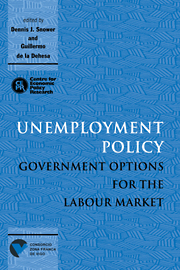Book contents
- Frontmatter
- Contents
- List of figures
- List of tables
- Preface
- Acknowledgements
- List of conference participants
- 1 Introduction
- PART ONE GENERAL POLICY ISSUES
- PART TWO DEMAND MANAGEMENT AND SUPPLY-SIDE POLICY
- PART THREE SUBSIDISING EMPLOYMENT AND TRAINING
- PART FOUR LABOUR MARKET REGULATIONS
- 12 An analysis of firing costs and their implications for unemployment policy
- Discussion
- Discussion
- 13 Labour market regulation and unemployment
- Discussion
- PART FIVE POLICY, JOB REALLOCATION AND THE UNEMPLOYMENT–PRODUCTIVITY RELATION
- PART SIX COMPARING UNEMPLOYMENT POLICIES
- Index
12 - An analysis of firing costs and their implications for unemployment policy
Published online by Cambridge University Press: 07 September 2010
- Frontmatter
- Contents
- List of figures
- List of tables
- Preface
- Acknowledgements
- List of conference participants
- 1 Introduction
- PART ONE GENERAL POLICY ISSUES
- PART TWO DEMAND MANAGEMENT AND SUPPLY-SIDE POLICY
- PART THREE SUBSIDISING EMPLOYMENT AND TRAINING
- PART FOUR LABOUR MARKET REGULATIONS
- 12 An analysis of firing costs and their implications for unemployment policy
- Discussion
- Discussion
- 13 Labour market regulation and unemployment
- Discussion
- PART FIVE POLICY, JOB REALLOCATION AND THE UNEMPLOYMENT–PRODUCTIVITY RELATION
- PART SIX COMPARING UNEMPLOYMENT POLICIES
- Index
Summary
Introduction
Mandatory firing costs were introduced in many European countries from the late 1950s through to the early 1970s. Although employment protection regulations in European countries were introduced at different times and for a variety of reasons, they have much in common, for example statutory pre-notification periods, consultation requirements, and minimum amounts for redundancy pay (Buechtemann, 1992). These restrictions on firing have been blamed by some commentators for the high levels of European unemployment since the first oil price shock of 1973. The fact that employment in the USA has been relatively less protected by state regulation, and US unemployment since 1973 has been lower than in Europe, has reinforced the popular view that firing costs contribute to the high levels of European unemployment. A purpose of this chapter is therefore to examine the question of whether or not firing costs, both bargained and state-mandated, increase unemployment.
A number of recent empirical and theoretical studies have invested the extent to which European unemployment and unemployment persistence can be explained by employment protection provisions. With the exception of Lazear (1990), these studies suggest that firing costs cannot be blamed for increasing European unemployment, although they are likely to have reduced employment variation (see, for example, Nickell, 1978; Bertola, 1990, 1992; Bentolila and Bertola, 1990). A conclusion is that firing costs affect employment dynamics more than the average level of employment. The fact that unemployment has been found to be more persistent in countries characterised by high job security provisions is argued by Bertola (1990, 1992) to reflect the stabilising effects of mandatory firing costs on aggregate employment.
- Type
- Chapter
- Information
- Unemployment PolicyGovernment Options for the Labour Market, pp. 359 - 388Publisher: Cambridge University PressPrint publication year: 1997
- 10
- Cited by



